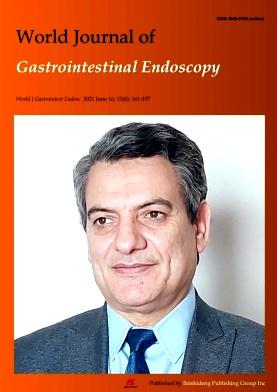Clinical usefulness of linked color imaging in identifying Helicobacter pylori infection: A systematic review and meta-analysis
IF 1.4
Q4 GASTROENTEROLOGY & HEPATOLOGY
引用次数: 0
Abstract
BACKGROUND Accurate diagnosis of Helicobacter pylori (H. pylori ) infection status is a crucial premise for eradication therapy, as well as evaluation of risk for gastric cancer. Recent progress on imaging enhancement endoscopy (IEE) made it possible to not only detect precancerous lesions and early gastrointestinal cancers but also to predict H. pylori infection in real time. As a novel IEE modality, linked color imaging (LCI) has exhibited its value on diagnosis of lesions of gastric mucosa through emphasizing minor differences of color tone. AIM To compare the efficacy of LCI for H. pylori active infection vs conventional white light imaging (WLI). METHODS PubMed, Embase, Embase and Cochrane Library were searched up to the end of April 11, 2022. The random-effects model was adopted to calculate the diagnostic efficacy of LCI and WLI. The calculation of sensitivity, specificity, and likelihood ratios were performed; symmetric receiver operator characteristic (SROC) curves and the areas under the SROC curves were computed. Quality of the included studies was chosen to assess using the quality assessment of diagnostic accuracy studies-2 tool. RESULTS Seven original studies were included in this study. The pooled sensitivity, specificity, positive likelihood rate, and negative likelihood rate of LCI for the diagnosis of H. pylori infection of gastric mucosa were 0.85 [95% confidence interval (CI): 0.76-0.92], 0.82 (95%CI: 0.78-0.85), 4.71 (95%CI: 3.7-5.9), and 0.18 (95%CI: 0.10-0.31) respectively, with diagnostic odds ratio = 26 (95%CI: 13-52), SROC = 0.87 (95%CI: 0.84-0.90), which showed superiority of diagnostic efficacy compared to WLI. CONCLUSION Our results showed LCI can improve efficacy of diagnosis on H. pylori infection, which represents a useful endoscopic evaluation modality for clinical practice.联动彩色成像在识别幽门螺旋杆菌感染方面的临床实用性:系统回顾和荟萃分析
背景 准确诊断幽门螺杆菌(H. pylori)感染状况是根除治疗和评估胃癌风险的重要前提。成像增强内镜(IEE)的最新进展不仅使检测癌前病变和早期胃肠道癌症成为可能,还能实时预测幽门螺杆菌感染情况。作为一种新型内镜检查方式,联动彩色成像(LCI)通过强调色调的细微差别,显示了其在诊断胃黏膜病变方面的价值。目的 比较联动彩色成像(LCI)与传统白光成像(WLI)对幽门螺杆菌活动性感染的疗效。方法 对截至 2022 年 4 月 11 日的 PubMed、Embase、Embase 和 Cochrane 图书馆进行检索。采用随机效应模型计算 LCI 和 WLI 的诊断效果。计算灵敏度、特异性和似然比;计算对称接收者操作特征曲线(SROC)和SROC曲线下面积。采用诊断准确性研究质量评估工具-2对纳入研究的质量进行评估。结果 本研究共纳入七项原创性研究。LCI诊断胃黏膜幽门螺杆菌感染的集合敏感性、特异性、阳性似然率和阴性似然率分别为0.85[95% 置信区间(CI):0.76-0.92]、0.82(95%CI:0.78-0.85)、4.71(95%CI:3.7-5.9)和 0.18(95%CI:0.10-0.31),诊断几率比=26(95%CI:13-52),SROC=0.87(95%CI:0.84-0.90),显示诊断效果优于 WLI。结论 我们的研究结果表明,LCI 可以提高幽门螺杆菌感染的诊断效果,是临床实践中一种有用的内镜评估方式。
本文章由计算机程序翻译,如有差异,请以英文原文为准。
求助全文
约1分钟内获得全文
求助全文

 求助内容:
求助内容: 应助结果提醒方式:
应助结果提醒方式:


